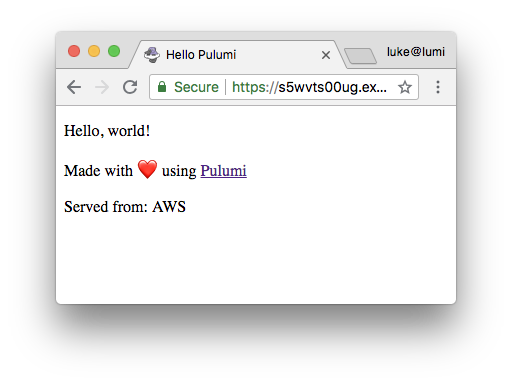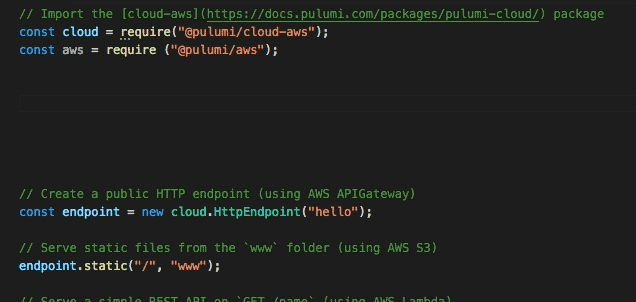Build your first serverless app using only JavaScript
Posted on
In this tutorial, we’ll use Pulumi to build a complete serverless application using only JavaScript. When we say ‘using only JavaScript’, we’re not kidding:
- write code just like an Express app… but end up with a fully deployable serverless app
- lambdas are… just lambdas
- no YAML required… freedom from indentation
- all the features of the V8 runtime… async await ahoy
- all the behaviors of immutable infrastructure as code tools… but we really mean ‘as code’
Pulumi also supports containers (including Kubernetes), managed services, infrastructure and everything else in between that you might need for building cloud applications. Better than that, you can even combine them all in the same program.
Our first serverless app in 5 lines of JavaScript
After installing the Pulumi CLI, just run the following to create your new serverless JavaScript app:
mkdir firstapp && cd firstapp
pulumi new hello-aws-javascript
This template creates a small index.js file (the main Pulumi code)
that is a simple but complete serverless application:
// Add the required package
const cloud = require("@pulumi/cloud-aws");
// Declare an HTTP endpoint
const endpoint = new cloud.API("hello");
// Serve up some static content on that endpoint
endpoint.static("/", "www");
// Create a simple serverless function responding to GET
endpoint.get("/source", (req, res) => res.json({name: "AWS"}));
// Publish the URL so we can easily access our app
exports.url = endpoint.publish().url;
So what’s happening here? This code creates a cloud.API which exposes
an HTTP endpoint to the internet. It serves static content at the root
of the API from what’s in the www folder on your local machine. And it
serves a REST API on GET /source which runs the JavaScript callback to
return the JSON object {name: “AWS”} (our serverless function).
Finally, it exports the URL where the HTTP API is exposed.
Now just run pulumi update to deploy the application. Before the app
deploys, you’ll get a preview of what will be deployed and you can
choose to go ahead with the full deployment. Pulumi figures out all of
the cloud resources needed to run the code above and prepares that for
deployment.

Once deployed, your application will run in the cloud. Use
pulumi stack output url to get the URL where your app is running, and
open it up in your browser:

With Pulumi, we’ve built a serverless JavaScript app in just a few lines of code. This approach avoided significant amounts of configuration (YAML, or point-and-click). Pulumi also supports containers (including Kubernetes), managed services, infrastructure and everything else in between that you might need for building cloud applications. Get started with Pulumi.
Why JavaScript for serverless programming?
There are many great reasons to use JavaScript for serverless programming (and cloud programming generally). Pulumi also supports TypeScript, Python, and Go with more languages on the way.
Pulumi uses NPM, Express, and supports modern JavaScript features like async await, module etc. and so you can bring your JavaScript skills directly to cloud programming.
Code is the best Config
Serverless platforms such as AWS Lambda offer an easy and cost-effective way to run your code in the cloud. But using these serverless platforms often requires learning lots of finicky details of the cloud platform, and using esoteric YAML configuration files to tell the cloud platform how to run your app. Often, the work needed to configure the app can outweigh the work needed to code the app.
Pulumi changes that, and lets you create serverless cloud applications using only JavaScript (or TypeScript). These applications can use all the features of cloud platforms like Amazon Web Services (AWS), Azure or Google Cloud Platform (GCP) - but exposed as simple JavaScript APIs on NPM.
This means that you can write code that contains logic alongside code that defines the services and infrastructure needed to run it and Pulumi can then deployed the app in seconds and run as a managed, scalable and - in the case of serverless apps such as this one - extremely low cost service on your chosen cloud.
Code is more productive, expressive, and… fun
One of the biggest advantages of a pure code approach is the automatic gains from better tooling support. In particular:
- Code completion. There are a lot of services in each cloud. Wouldn’t it be great to be able to autocomplete?
- Error checking. Less worry about correctly indented YAML, more real error checking.
- Versioning and Packaging. Much improved versioning and packaging scenarios through Github and NPM workflows.
- Reusable components. Build on top of base classes, and share for easy reuse, standard configurations and so on.

Want more?
To learn more take a look at more tutorials and example code:

